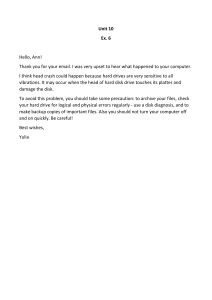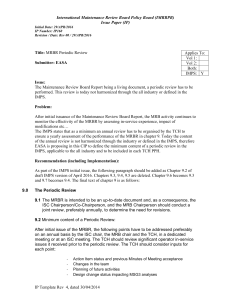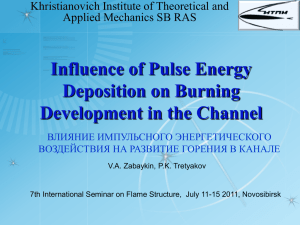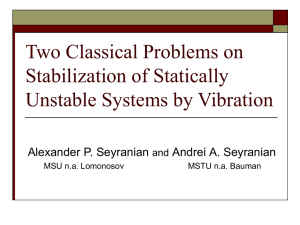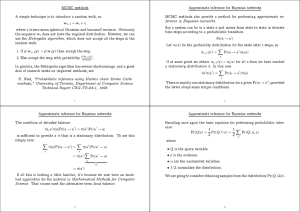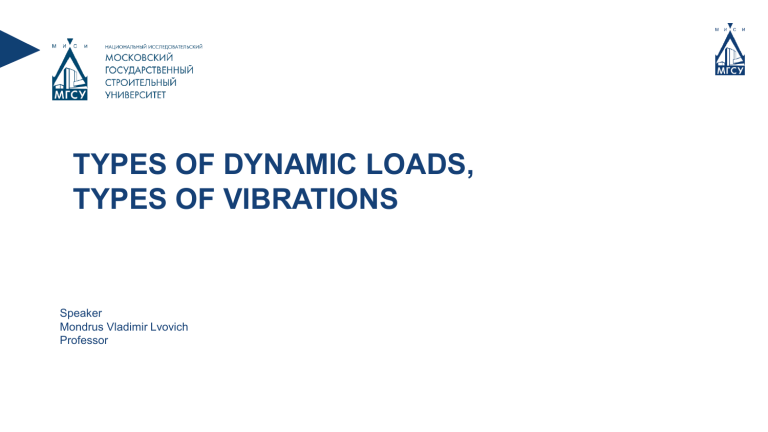
TYPES OF DYNAMIC LOADS, TYPES OF VIBRATIONS Speaker Mondrus Vladimir Lvovich Professor 1 Definition Dynamic loads are called the loads acting on the structure, the magnitude, direction, and position of which change over a short period of time. The purpose of the structural dynamic calculation is to determine the law of the masses motion of the deforming system and the magnitude of the inertial forces • Allow to check the system for resonance • Give an assessment of the strength and stiffness of the calculated structure Dynamic loads • Vibration load - periodic vibrational effects from the movement of unbalanced parts of machines and mechanisms, in particular, electric motors, looms, etc. Simple harmonic load Complex load Dynamic loads • The impact load created by the falling parts of the mechanisms (hammers, copres, etc.). • These loads are characterized by a short duration of action. • The maximum value of the load and the time of its action depend on the elastic and inertial properties of the structures that perceive the impact. Dynamic loads • Movable load, the position of which changes in time, for example, the load from the movement of railway trains, bridge cranes, etc. Dynamic loads • Impulse load: explosion, wave load, causing a sharp change in pressure on the surface of the structure Dynamic loads • Seismic load on buildings and structures caused by an earthquake, causing the occurrence of base movements, changing in time according to a complex law - a seismogram and, as a result, causing vibrations of the structure. • The parameters of the seismic impact cannot be accurately set in advance. Dynamic loads Wind load is the load, in pounds per square foot, placed on the exterior of a structure by wind. This will depend on: • The angle at which the wind strikes the structure • The shape of the structure (height, width, etc.) Wind exerts three types of forces on a structure: • Uplift load - Wind flow pressures that create a strong lifting effect, much like the effect on airplane wings. Wind flow under a roof pushes upward; wind flow over a roof pulls upward. • Shear load – Horizontal wind pressure that could cause racking of walls, making a building tilt. • Lateral load – Horizontal pushing and pulling pressure on walls that could make a structure slide off the foundation or overturn. VIBRATIONS у у0 free vibrations Т А φ0/ω To start free vibrations only, the force is required initially The frequency of free vibrations depends on the natural frequency t А Free vibrations are produced when body is disturbed from its equilibrium position and released Energy of body remains constant in the absence of friction, air resistance, etc. Due to damping forces, total energy decreases. Graph of free non-extinguishing harmonic oscillations Amplitude of vibrations decreases with time у R J =1 External load action P(t) forced vibrations Forced vibrations are produced by an external periodic force of any frequency Continuous external periodic force is required. If external periodic force is stopped then forced vibrations also stop The frequency of forced vibrations depends on the frequency of the external periodic force Energy of the body is maintained constant by the external periodic force acts on it Amplitude is small but remains constant as long as external periodic force acts on it Vibrations stop as soon as external periodic force is stopped VIBRATIONS VIBRATIONS impulse (impact) processes deterministic processes periodic harmonic complex periodic nonperiodic almost periodic random processes transient stationary ergodic nonergodic nonstationary VIBRATIONS • Deterministic processes are oscillatory processes that can be described by specific mathematical expressions. • They can be periodic or non-periodic. periodic complex periodic • In turn, periodic processes are divided into harmonic and complex. almost periodic • The dependence of the maximum amplitude of oscillations on the frequency of oscillations is called the spectrum. damped process The spectrum of periodic and almost periodic processes is characterized by discrete distributions in the coordinate system "Amplitude-frequency of oscillations" VIBRATIONS • Complex harmonic processes - a periodic oscillatory process that has the same frequency at different times, but different amplitudes 𝑢 𝑡 = 𝑢(𝑡 + 𝑛𝑇0 ) Complex harmonic processes can be expanded in a Fourier series according to the formula: ∞ 𝑎0 𝑢 𝑡 = + 𝑎𝑛 cos 2𝜋𝑛𝑓1 𝑡 + 𝑏𝑛 sin 2𝜋𝑛𝑓1 𝑡 2 2 𝑇0 2 𝑏𝑛 = 𝑇0 𝑛=1 𝑇0 𝑎𝑛 = 𝑢 𝑡 cos 𝜔1 𝑛𝑡 𝑑𝑡 0 𝑇0 0 𝑢(𝑡) sin 𝜔1 𝑛𝑡 𝑑𝑡, 𝑤ℎ𝑒𝑟𝑒 𝑓1 = 𝜔1 = 2𝜋𝑓1 𝑇0 - period 1 𝑇0 VIBRATIONS • Transient processes are such processes for which in most cases the spectral distribution is continuous and can be represented as a Fourier transform. ∞ 𝑈 𝑓 = 𝑢 𝑡 𝑒 −𝑖𝜔𝑡 𝑑𝑡 , −∞ wℎ𝑒𝑟𝑒 𝜔 = 2𝜋𝑓 − 𝑐𝑖𝑟𝑐𝑢𝑙𝑎𝑟 𝑜𝑠𝑐𝑖𝑙𝑙𝑎𝑡𝑖𝑜𝑛 𝑓𝑟𝑒𝑞𝑢𝑒𝑛𝑐𝑦 VIBRATIONS • A random function is a function that, as a result of an experiment, can take on some unknown form. • All realizations of a specific random event (earthquake, wind gusts, voltage on the transformer winding, pressure distribution during explosions and vibrations, etc.) over a finite observation interval is called a random or stochastic process. VIBRATIONS • Random processes are divided into stationary and nonstationary. • Stationary processes can be represented as ergodic or nonergodic processes. A random process is called stationary if the probability distribution laws of two value groups: 𝑋 𝑡1 , 𝑋 𝑡2 , … , 𝑋 𝑡𝑛 𝑎𝑛𝑑 𝑋 𝑡1 + 𝜏 , 𝑋 𝑡2 + 𝜏 , … , 𝑋 𝑡𝑛 + 𝜏 are identical to each other, and the quantities 𝑛, 𝑡1 , 𝑡2 … 𝑡𝑛 and 𝜏 are chosen arbitrarily → the distribution functions do not depend on the choice of the origin of time VIBRATIONS • A random process is called ergodic if any of its realizations has the same statistical properties, i.e. the statistical characteristic obtained by averaging over a set of realizations is equal to the statistical characteristic obtained by averaging the process over time. Non-ergodic process Ergodic process VIBRATIONS • Among the oscillatory processes that are not stationary, in particular, there are damped and divergent oscillations. • Damping is an influence within or upon an oscillatory system that has the effect of reducing or preventing its oscillation. THANK YOU FOR YOUR ATTENTION 18
